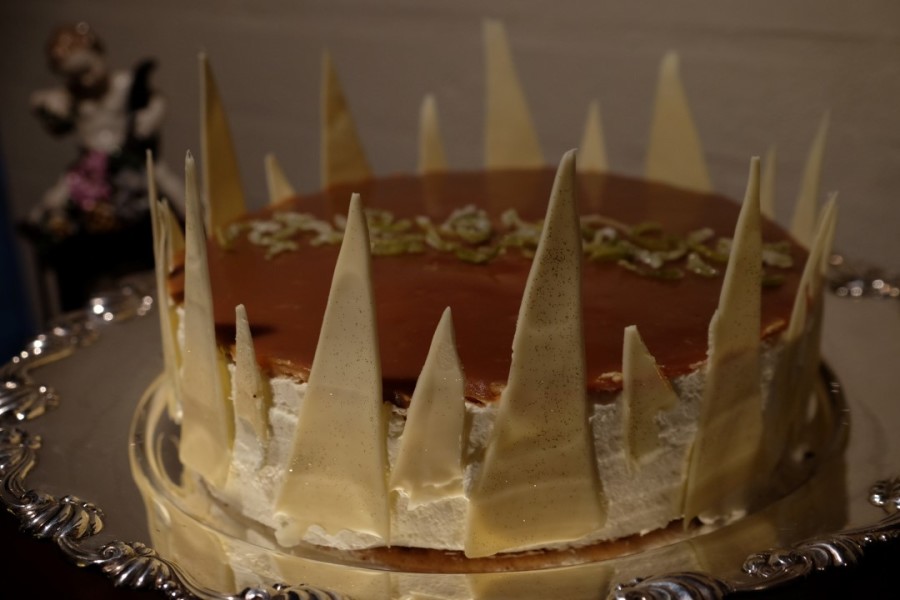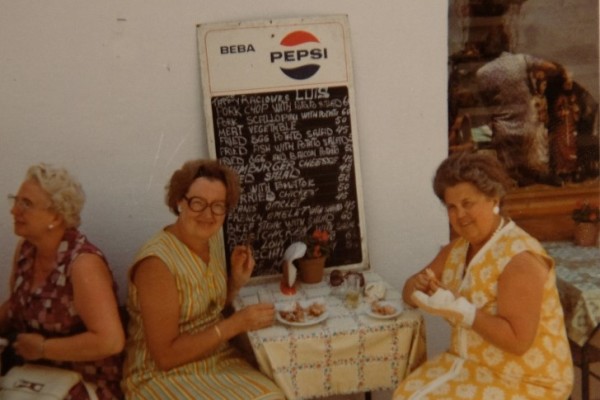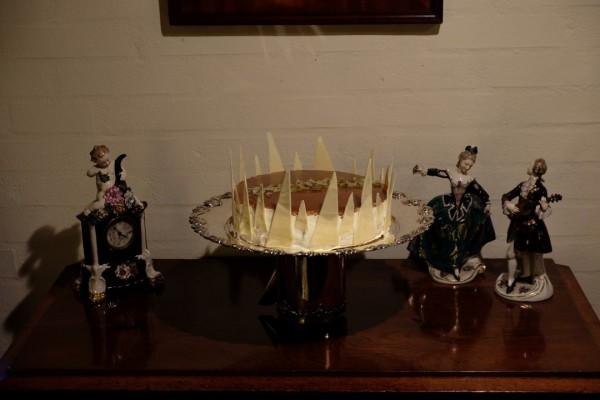Last week was Aunt Mona’s 100-year birthday. She was born in Copenhagen on the 17th of December 1915 and died in Copenhagen on the 11th of October 2010. Aunt Mona was my grandmother’s cousin and a close member of the family for as long as I can remember. For many years she was also the person around which my Monday nights revolved.
When I describe Aunt Mona, I tend to stress how she was knowledgeable, curious, decent, a lover of red wine and cheroots. And I do believe that this is a correct assessment of her character, however, it was not always without trepidation that we turned up at the doorstep of Herninggade 2. Aunt Mona sometimes had less amusing days, where the frustration of being old with all that came with it of increasing need for home care, vision problems and general physical hardships filled her with frustration. On those days, my sister would place herself on the floor in the lotus position, while I immediately disappeared into the tiny kitchen knowing that my sister emanates a certain calm that spreads like ripples on the water. When I dared look into the living room again, usually calm was restored aided and abetted by a gin and tonic.
[Aunt Mona was a permanent presence throughout our childhood, youth and adulthood until her death in 2010. From the right: Robyn and Aunt Mona – 1990, Rikke and Aunt Mona playing – 1973, Rikke and Aunt Mona having fun]
Monday night consisted of certain fixed elements – the sorting of pills for the week, making grocery lists, watering flowers, eating and talking. The routine already began at work, where we asked our colleagues for suggestions for the dinner menu. We were not afraid of exposing Aunt Mona to culinary adventures. When we served her sushi, she nodded appreciatively, mostly, I think, in support of our constant praise of the delicious food. Then she said: “yes well, maybe it would be more appropriate as a starter, since everything tastes the same”. We got a markedly different response, when we served traditional Danish dishes like pot roast chicken with gravy, fried pork with parsley sauce and chopped steak with caramelized onions. There was never any doubt that her favourite dishes belonged to the Danish cuisine. And desserts, of course.
Dessert was obligatory, like red wine and cheroots. As I recollect, the first couple of years we consumed more red wine than is common on a Monday night, and I remember that my sister and I often went home, if not singing, then surely engrossed in deep and intense conversation. Of course, you should not judge a woman in her nineties on her ability to stay up very late while consuming considerable amounts of red wine and cheroots in the company of two younger women, one of them born around the time she was retired. But it does profess to a certain largeness of spirit, if you ask me.
[My grandmother often went south with her cousins, Aunt Mona and Aunt Britta. My grandfather was grateful, since it meant he could stay at home. Going through the holiday albums is a study in good food, good company and colourful dresses. From the right: Ibiza – 1974, Rhodos – 1971, Costa del Sol – 1973.]
Back to desserts. There was only one thing Aunt Mona loved more than the Danish dishes, and that was desserts, Danish as well as international. All kinds of sweets. I never heard her give a dessert the sushi-treatment, which meant that we diligently – every Monday – made sure there was dessert, and enough to last her through Tuesday as well. Sometimes we made something special, but just as often a crumble put together in five minutes, and every now and then merely a berry pie from the freezer in the supermarket (with whipped cream, of course!). Whatever we came up with, it was always appreciated.
The best thing, however, was lagkage. If Aunt Mona was at a birthday and the opportunity presented itself, she gladly accepted to take home a piece for breakfast the following day, because that was when it tasted the best. Surely, the best way to celebrate a lover of cakes and sweets, then, is by making her a lagkage. Her very own. One last dessert from a devoted niece to dear Aunt Mona.
I miss Monday night. It is difficult – perhaps impossible to write about a person you have loved dearly without getting profanely sentimental. So before I risk it, I will disappear into my kitchen and pour it into a cake instead. As those types of texts often are, so will this cake be. Rich and ever so slightly nauseating.
I have borrowed the main elements of the cake from other recipes that I have used many times and like immensely. For instance, the almond sponges are from Mette Blomsterberg’s raspberry birthday cake, while the lime and white chocolate mousse is from a-piece-of-heaven cake found on the blog Copenhagen Cakes.

Aunt Mona’s lagkage with white chocolate, lime and salt caramel.
Almond sponges:
100 g. pasteurized egg yolks
65 g. sugar
1 tsp baking powder
100 g. flour
50 g. of finely blended almonds
200 g. pasteurized egg whites
Lime mousse:
300 g. White chocolate
4 pasteurized egg yolks
3 tbsp. of icing sugar
250 g. mascarpone
200 g. sour cream (I use 18%)
2 organic limes, peel and juice
1,5 dl cream
Caramel:
200 g. sugar
50 g. butter
2 dl cream
1,5 tsp. Sea salt
Process:
Sponges: Whisk egg yolks and sugar to eggnog. Mix flour and baking powder and carefully fold it into the eggnog with the finely blended almonds. Whisk the egg yolks until they set and carefully fold it into the eggnog. Keep going until dough is even. Cut a piece of parchment paper to fit into the bottom of a springform pan (25 cm) and gently pour the mass into it.
Bake the sponge cake at 190 degrees Celsius for approx. 20-25 min, and cool it down completely before gently loosening the cake from the form. Cut the cake horizontally into two pieces.
Mousse: Melt the white chocolate and put it aside. Pour the egg yolks into a bowl and add acing sugar Whisk it till it foams and the colour lightens. Add Mascarpone, sour cream, lime juice and peel.
Whip the cream in a separate bowl and add it to the mascarpone cream (if you cannot get the lumps out, whisk it with a hand mixer. Add the melted chocolate and pour half the cream on top of the sponge, then carefully place the second sponge on top of the cream, and finally add the rest of the cream on the sponge. Smooth the surface and refrigerate overnight (or at least for four hours).
And now for the caramel! I saw a Youtube video of an American woman, who despite all the dire warnings, stirred the sugar like a mad woman, and it turned out excellent, so that is what I do as well. A heavy bottomed pot, relatively high heat (7 out of 12), watch carefully, when it starts melting around the edges, stir – stir – stir, until all the sugar has melted, then cream, EXPLOSION, big chewy mass, but keep stirring gently, it WILL melt. Then it is done. Remember to let it simmer a while, if you want it a bit firm. Then add butter and salt. Cool it down to room temperature and pour it carefully over the top of the cooled cake.
When the caramel has cooled off, free it from the sides of the springform pan carefully using a knife. Then decorate the cake, as you like. I used candied lime and white chocolate.
Candied lime:
200 g. sugar
1 dl water
Peel of 6 lime fruits and water to boil it in
Chocolate decoration:
100 g. white chocolate
1,5 dl whipped cream
Proces:
Chocolate decorations: Melt the chocolate and spread it out on a piece of parchment paper. Draw the shapes you would like in the warm chocolate. Sprinkle with gold dust (yes, of course you need gold dust, otherwise it will mess up the entire enterprise!), and set aside to cool off. Whip the cream and apply a thin layer of whipped cream to the sides of the cake (so the chocolate feels at home and decides to hang out) When the chocolate has hardened, break it into the shapes you drew, and use it to decorate the cake.
Candied lime: Remove the peel and boil it twice for five minutes at a time. Change the water in between. Now put sugar and water to the boil and add the peel. Let it simmer for about 20 minutes and fish the peel out of the syrup. Sprinkle them with sugar and put them in the oven at 60 degrees for about 45 minutes. Put them in an airtight container to keep them from sticking. (You can add lime juice to the excess syrup. Put it to the boil, cool it down and eat with vanilla ice cream. Nice)
[All cake pictures were shot by Sake Kooistra]








